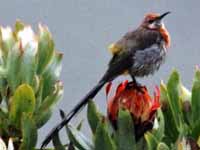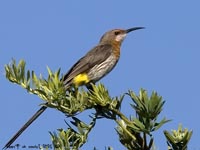The Modulatricidae are thrush-like or babbler-like birds that have been determined to be relatate to neither thrushes nor babblers. Their closest relatives appear to be the sugarbirds even though those birds have very long tails and are have evolved to prefer nectar from flowers. The Modulatricidae are shy birds that are found in the dense understory of forests is seem to prefer a det of insects and spiders. They are shy and elusive, so much is not known about their habits.
Genus Arcanator - 1 species
Dapple-throat Arcanator orostruthus
Description: The dapple-throat has greenish-brown upperparts. The underparts are pale yellow with thick wavy brown streaks. It is a shy resident of forest floors where it is very difficult to observe. The dapple-throat is up to 19 cm long.
Range: Mozambique, Tanzania.
Habitat: Dense and wet montane forests.
Diet: Unknown.
Conservation status: It is listed as Near Threatened due to logging of its habitat.
Image by: 1) USUWSRange: Mozambique, Tanzania.
Habitat: Dense and wet montane forests.
Diet: Unknown.
Conservation status: It is listed as Near Threatened due to logging of its habitat.
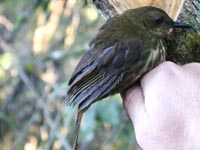
Genus Kalso known asmega - 1 species
Illadopsis,_grey-chested Kasamega poliothorax Found: Africa
Description: The grey-chested illadopsis, also known as the grey-chested babbler, is thrush-like in appearance. It has reddish-brown upperparts, grey underparts, and a paler throat. The grey-chested illadopsis is up to 17 cm long.
Range: Nigeria, Cameroon, DR Congo, Kenya.
Habitat: Montane forest understory.
Diet: Insects.
Conservation status: Least Concern.
Range: Nigeria, Cameroon, DR Congo, Kenya.
Habitat: Montane forest understory.
Diet: Insects.
Conservation status: Least Concern.
Genus Modulatrix
Spot-throat Modulatrix stictigula Found: Africa
Description: The spot-throat has dark brown upperparts, a mottled paler throat, whitish eye-ring, and a chestnut breast.
Range: Tanzania, northern Malawi.
Habitat: Understory of moist mature montane forests or near by such forests.
Diet: Insects and spiders.
Conservation status: Least Concern.
Image by: 1) Dick Daniels - specimen in Nairobi National Museum, Kenya Range: Tanzania, northern Malawi.
Habitat: Understory of moist mature montane forests or near by such forests.
Diet: Insects and spiders.
Conservation status: Least Concern.
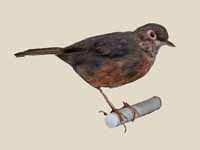
The two species of sugarbirds are restricted entirely to southern Africa. They have few if any close relatives. In general appearance as well as habits they resemble large long-tailed sunbirds. Also, their tongues are similar to those of honeyeaters, but this is because of convergent evolution. They have brownish plumage, the long down-curved bill typical of passerine nectar feeders, and long tail feathers.
Nectar from protea bushes provide most of the energy these species require, and they are considered significant pollinators of the genus. The birds' diet is supplemented by insects attracted to the protea flowers.
Genus Promerops
Sugarbird,_Cape Promerops cafer
Description: The cape sugarbird has brown upperparts. The crown is grey-brown, but the fore-crown may appear yellow because of pollen. It has a dark grey down-curved and long bill. The underparts are mostly off-white with thin streaks except there is some brown on the breast. The under-tail is bright yellow. The female has a long tail and the male has a much longer one.
Range: South Africa.
Habitat: Regions of flowering proteas and ericas. Other flowers in general.
Diet: Nectar from flowers which it gets via its long brush-tipped tongue. Also insects, spiders.
Conservation status: Least Concern.
Image by: 1) Craig Adam - Hermanus, South Africa 2) DerekKeats 3) Lip_kee 4) Derek_Keats - South AfricaRange: South Africa.
Habitat: Regions of flowering proteas and ericas. Other flowers in general.
Diet: Nectar from flowers which it gets via its long brush-tipped tongue. Also insects, spiders.
Conservation status: Least Concern.
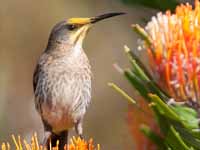
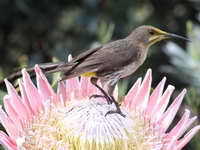
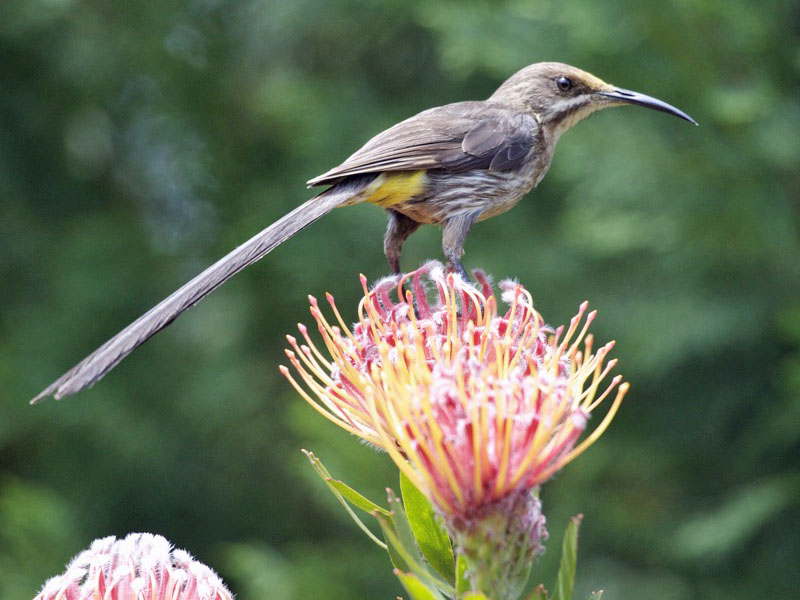
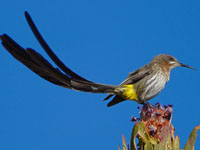
Sugarbird,_Gurney's Promerops gurneyi
Description: The Gurney's sugarbird has dark grey upperparts and a bright yellow rump. The crown is grey-brown, the face is grey and the throat is white. It has a russet breast and off-white underparts with grey streaks. The female has a long tail and the male has a much longer one. Its russet breast differentiates it from the cape sugarbird.
Range: Southern Africa.
Habitat: Shrublands.
Diet: Nectar from flowers which it gets via its long brush-tipped tongue. Also insects, spiders.
Conservation status: It is listed as Near Threatened because fires are reducing its habitat.
Image by: 1) Derek_Keats 2) Alan Manson 3) Patty McGann 4) Johann_duPreez - South AfricaRange: Southern Africa.
Habitat: Shrublands.
Diet: Nectar from flowers which it gets via its long brush-tipped tongue. Also insects, spiders.
Conservation status: It is listed as Near Threatened because fires are reducing its habitat.


